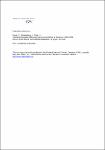Trends in Imported Chikungunya Virus Infections in Germany, 2006–2009
Frank, Christina
Schöneberg, Irene
Stark, Klaus
Chikungunya virus (CHIKV) has been previously reported in many African and Asian areas, but it recently reemerged strongly in countries bordering the Indian Ocean as well as caused an outbreak in northern Italy. In Germany, where potential CHIKV vectors are not yet established, CHIKV infection is mandatorily notifiable. Cases reported from 2006 through 2009 were analyzed for travel characteristics and demographic factors. 152 cases of symptomatic CHIKV infection were notified. Both sexes were affected, with a median age of 46 years. Over the years, countries of infection largely followed the outbreaks reported from various travel destinations. India and the Maldives were the countries of infection most frequently named. In Sri Lanka, India, and Thailand, which are also frequently named countries of infection for dengue virus, the median age of CHIKV-affected patients was higher than that of dengue fever patients. Taking traveler numbers into consideration, risk of CHIKV infection was higher in the Seychelles and Mauritius than in Thailand and India. Even though substantial underdiagnosis is suspected, this assessment of CHIKV importation to Germany offers valuable information about the details of travel-associated cases. Between 17 and 53 notified cases per year signify that CHIKV would be occasionally available for local transmission in Germany once a vector becomes present. Although CHIKV most often causes a comparatively mild disease, the high median age of notified cases and the higher age than dengue patients support more severe disease courses in older adults. Travelers to all CHIKV endemic areas should protect against mosquito bites. In Germany, CHIKV surveillance will be continued to monitor ongoing importation of the virus and to detect early potential autochthonous cases.
No license information

